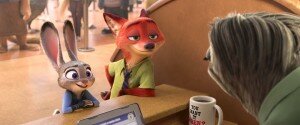Zootopia Review
By Adam Yuster
I’m going to make a controversial statement: Zootopia is better than Frozen. Now before the claws come out (pun intended), give me a chance to explain myself. I recognize that I may be biased. I’ve never been much of a Frozen fan. I mean, no one can deny the catchy 3 minutes and 44 seconds of awesomeness that is “Let It Go”, but otherwise I thought Frozen was a rather formulaic and middle-of-the-road Disney flick. It injected some new life into the formula by incorporating themes of feminism and sisterhood, but it still felt pretty much like a safe, standard Disney Princess film—one we’ve seen many times over.
Zootopia, on the other hand, is a shock to the system. It takes the formula and smashes it with a hammer. This is not your mommy’s Disney movie. Heck, it’s not even your little sister’s Pixar movie. It’s risky. VERY risky. Its plot is allegorical and its reliance on political overtones (yes, there are those—more on that later) could’ve killed the movie. Instead, those risks paid off in spades. Zootopia is brash, bold, funny, inventive, and possibly the best Disney movie of the past 10 years.
If you don’t know what Zootopia is, you’ve probably been living under a rock. It’s been advertised on TV for months and promotional pictures decorate practically every bus in Manhattan. Here’s the synopsis: In a world where all animals have evolved to walk, talk, and dress in cute little outfits, including, but not limited to, tuxedos, a young rabbit named Judy Hopps (Ginnifer Goodwin) dreams of becoming a cop in the big city, Zootopia. Flash forward about 10 years later. Judy makes her dreams come true and becomes the first bunny on the police force. Unfortunately, she soon learns there is an unspoken divide in Zootopia between “predators” and “prey”. Though they are supposed to coexist peacefully due to a recent law, the city is actually run by the predator animals. Judy is dismayed to find that, because bunnies are considered prey, she’s only a cop on paper. Chief Bogo (Idris Elba), designates Judy as a meter maid to keep her far away from real police work, which is handled by the predators on the force. When Judy goes against the chief’s word and takes the case of an otter trying to find her missing husband, she and her reluctant partner, a con man and fox (or is it con fox?) named Nick Wilde, have 48 hours to solve the case or else Judy is fired.
The story itself is a unique take on the mystery/detective genre that, outside of maybe The Great Mouse Detective, hasn’t really been done before in a Disney movie. The real magic is how seamlessly the story and world-building in Zootopia go together. The concept of having several types of animals go missing (we later discover there are more missing than just Mr. Otterman) is a great motivator for the plot, but it’s also a solid excuse to take us through the diverse neighborhoods of Zootopia without feeling derivative. And, much like The Simpsons, Zootopia has memorable side characters whose scenes provide some of the best visual jokes of the movie while also being vital to the central investigation. For example, there is a scene with a sloth named Flash who works at the DMV that is laugh-out-loud funny, but he’s not there randomly; no, Nick and Judy have to meet with him so he can run license plates. There is another scene involving a family of rodents that heavily parodies The Godfather, and that scene is also necessary, because Nick and Judy receive information that furthers their case. Basically, Zootopia would rather effectively set up its story and setting than go for the cheap joke, and that is, in part, what makes it stand out from its kiddie fare contemporaries.
The other major component that makes Zootopia stand out—and this is a big one—is its treatment of racism. Yes, folks, it’s true. This film with a target audience of preschoolers and up courageously tackles racism. Not only that, but it tackles racism more thoughtfully and earnestly than most live-action films by building and then deconstructing a stereotype. What do I mean by this? Well, after I saw the first 10 minutes of the film, I thought I had Zootopia figured out. Due to the predators’ positions of power and the preys’ subordinance, I thought the predators were the embodiment of the white masses and the prey were quite obviously comparable to minorities. For most of the movie, I smugly believed this theory, so that when one of the government officials in the predator group was arrested for corruption, I became afraid the movie was going to take the easy way out by following a predictable path of the “beloved good guy turns out to be a bad guy” routine. But I shouldn’t have written off that moment so soon, because it’s at that point, when fear in Zootopia reaches a fever pitch, that the truth is revealed: prey comprises 90% of Zootopia’s population. That’s right, the predators are the minority. Everything the movie teaches the audience about predators’ short tempers, toughness, and savage nature is one massive stereotype. And the most satisfying part is, we only realize we’ve been duped into embracing a stereotype the moment Judy realizes she’s been subconsciously perpetuating the stereotype itself. Animated children’s movie or not, the ability to synchronize the audience’s realizations with those of the protagonist is nothing more or less than the mark of great moviemaking.
I’ve done a lot of gushing so far, but every movie has its flaws, and Zootopia is no exception. Although, admittedly, it pains me to point out holes in a movie that works so well and has a great universal message, there are a few structural and logistic issues with Zootopia. First of all, the story sometimes is so fast-moving that the development of Nick and Judy’s friendship doesn’t exactly match up. I accept that Judy and Nick become fast friends within the course of 48 hours, but I do not accept that after belittling and mocking her for much of the first 30 minutes, Nick suddenly comes to Judy’s aid when he sees the chief chewing her out. If the message is supposed to be that outcasts stick up for each other, as I believe it was intended to be, there could’ve been a better way to communicate that, possibly by having Nick stick up for someone else in need earlier in the film. The other thing that could’ve been clarified is the origin of flowers called night howlers, which are introduced late in the 2nd act as the reason why some animals are “going savage”. It’s never explained in Zootopia why the flowers have this effect, how they are distributed, and why they haven’t been a problem before. Instead there is more of a mysterious air around them, and the only important question Judy and Nick get answered by the film’s end is who is behind the sudden appearance of the flowers in Zootopia. The lack of explanation is a relatively minor issue overall, but it did bug me that the writers and directors didn’t devote any time whatsoever to divulging into the backstory behind the flowers.
All in all, Zootopia is a stellar film. But possibly the best thing about it, something that will always place it above Frozen in my mind, is that it’s very relevant right now. In the wake of Eric Garner, #OscarsSoWhite, and recent political discussions regarding illegal immigrants it is important, now more than ever to teach the next generation what racism is and how to prevent it. Zootopia does just that by delivering the central message with humor, sweetness, and artistry.
Rating: 9/10







